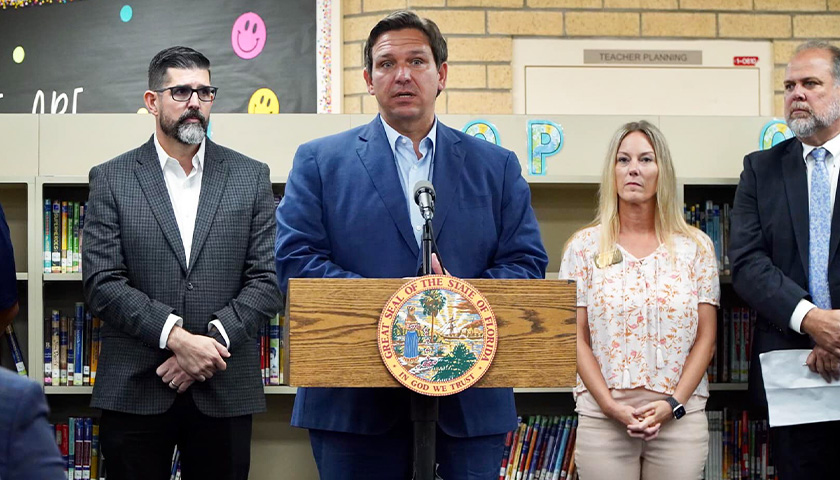by Bethany Blankley
The 2022 National Assessment of Educational Progress (NAEP) rankings indicate that Florida students are “well ahead of their peers, especially with younger and educationally at-risk students who were harmed the most from distance-learning in other states,” the governor said.
“We insisted on keeping schools open and guaranteed in-person learning in 2020 because we knew there would be widespread harm to our students if students were locked out,” Gov. Ron DeSantis said. The results, he said, “once again prove that we made the right decision.”
The NAEP scores, which came out this week, ranked Florida’s students third nationwide in Grade 4 reading and fourth in Grade 4 mathematics. Florida fourth-graders’ average math score was 241; the national average was 235 among public school students. Florida fourth-graders’ average reading score was 225; the national average was 216 among public school students.
“We also knew that younger and at-risk students would be the most impacted if schools were closed, and the results speak for themselves,” DeSantis added, pointing out that Florida’s fourth-graders ranked in the top 4 in both english and math for the first time in state history. Meanwhile, he notes, students in “lockdown California and New York aren’t even in the top 30.”
Florida’s 4th and 8th grade students earned the state’s highest ever rankings in each assessment and demonstrated historic achievement gap closure for at-risk students at all levels, according to the data. Florida’s Hispanic, Black and disabled students all scored in the top 10 in every category.
NAEP assessments, known as the “Nation’s Report Card,” are administered every two years and are the only assessments consistently taken nationwide. The NAEP was last administered in 2019; the 2021 assessments were delayed to 2022.
“If we are meant to measure our impact by how we elevate our young generation, especially those most at-risk, Florida is clearly the #1 state in the nation in elevating its young people,” state Education Commissioner Manny Diaz, Jr., said. “Florida’s Hispanic and Black students, students with unique abilities, and students on free and reduced price lunch massively narrowed achievement gaps and proved the value of being in school in a classroom with their peers and learning in-person from Florida’s world-class teachers.”
In June, the state Department of Education released its initial English Language Arts (ELA) Grade 3 Florida Standards Assessment results. They indicated that districts with higher rates of in-person instruction had more consistent learning outcomes between 2019 and 2021. Achievement gaps also narrowed for Florida’s Black and Hispanic students, who experienced less of a decline than Caucasian students.
“On June 11, 2020, Commissioner Corcoran and I stood with our school district superintendents and said our schools will be open,” DeSantis said at the time. “Throughout the year we continued to work with districts to get struggling students on campus full-time to stop learning loss and the possibility of widening achievement gaps.”12 students are positioned for success better than any other state in the nation.”
According to the Florida DOE, 68% of students were on school campuses in person full-time; 80% were on campus full- or part-time. By spring 2021, 97% of Grade 3 students tested in-person. The majority of students, between 92% and 94%, took Florida’s state tests (ELA Writing, ELA Reading, Mathematics and end-of-course exams).
By September 2021, Education Week’s 2021 Quality Counts assessment ranked Florida third nationwide for K-12 Achievement. Florida ranked second for improving its high school graduation rate, third for improvement in Grade 4 math, fourth for improvement in Grade 8 reading and Grade 4 poverty gap, sixth for proficiency in Grade 4 math and for improving high advanced placement test scores, seventh for the size of its Grade 4 Reading poverty gap and improving its Grade 8 poverty gap, and eighth for improving Grade 4 Reading and for successful Grade 11 and 12 advanced placement test scores.
By June 2022, Florida’s Math and ELA test results showed gains in math and ELA metrics for Hispanic, Black and economically disadvantages students, the DOE reported.
One month later, the Florida DOE reported that grades for the 2021-2022 academic year exceeded expectations: 53 schools exited the School Improvement Support list in 2022; 100% of schools graded F in 2019 improved their grades in 2022, including one earning a B and six earning a C.
The majority of schools, 84%, that earned D and F grades in 2019 improved in 2022. Overall, 469 schools increased their grade in 2022; 825 schools maintained an A grade, 348 schools maintained a B grade.
While Florida’s students improved, the NAEP scores nationwide declined in reading and math.
“In many states, this decline was due to government-imposed lockdowns and school closures,” DeSantis said.
– – –
Bethany Blankley is a regular contributor to The Center Square.
Photo “Ron DeSantis” by Governor Ron DeSantis.





AND… wouldn’t it be very ugli IF this wasn’t what any of 5th grade average intelligence didn’t believe back when every Bleu Metro shuttered their schools…
… kicked out students for a week IF any around them got Covid…
… like Palm Beach County DID to both my grandesons!!
That is why we have the term: CommieNaziRatBastard!!